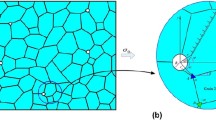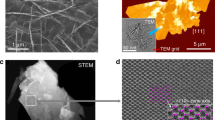Abstract
In this work, a 2D time-dependent Bridgman model has been used to analyze the impact of the inertial flight mode on the resulting crystal dopant homogeneity. To be as near as possible to the experimentalists, the discussion has been based on the computed solid dopant segregation. Excepting a few cases at the lowest value of gravity, 1 μg, the model is amazingly sensitive to the orbital characteristics. In effect, alternated dopant structures appear recorded in the solid phases as clear fingerprints of the nonlinear vibroconvective flow effects acting along the simulated growth processes. Thus, to improve crystal homogeneity, some strategies should be introduced to eliminate also these pernicious effects.
Similar content being viewed by others
REFERENCES
Nelson, E.S., An Examination of Anticipated G-Jitter on Space Station and Its Effects on Materials Processes, NASA Technical Memorandum 103775, 1991.
Danilewsky, A.N. and Benz, K.W., InP Growth from In Solutions under Reduced Gravity, J. Cryst. Growth, 1989, no. 97, p. 571.
Danilewsky, A.N., Boschert, St., and Benz, K.W., The Effect of the Orbiters Attitude on the µg-Growth of InP Crystals, Microgravity Sci. Technol., 1997, X/2, p. 106.
Boschert, St., Danilewsky, A.N., and Benz, K.W., Numerical Simulation of the Influence of the Orbiters Attitude on the µg-Growth of InP:S Crystals from an In Solution during the EURECA-1 Flight, J. Cryst. Growth, 1999, no. 205, p. 92.
Alexander, J.I.D., Ouazzani, J., and Rosenberger, F., Analysis of the Low Gravity Tolerance of Bridgman-Stockbarber Crystal Growth. I. Steady and Impulse Accelerations, J. Cryst. Growth, 1989, no. 97, p. 285.
Alexander, J.I.D., Garandet, J.P., Favier, J.J., and Lizée, A., G-Jitter Effects on Segregation during Directional Solidification of Tin-Bismuth in the MEPHISTO Furnace Facility, J. Cryst. Growth, 1997, no. 178, p. 657.
Alexandre, J.I.D. and Banish, R.M., Modeling G-Sensitivity of Low-Gravity Experiments, Microg. Sci. Tech., 1998, no. 11, p. 90.
Chernatynski, V.I., Gershuni, G.Z., Monti, R., and Savino, R., Transient Effects of G-Pulses in a Fluid Cell Heated from Below, Microgravity Quarterly, 1995, no. 5, p. 152.
Monti, R., Savino, R., and Alterio, G., Modeling and Simulation of G-Jitter Effects on Fluid Science Experimentation. Impact on the Utilization of the ISS, Acta Astronautica, 1997, no. 40, p. 369.
Nikitin, S.A., Polezhaev, V.I., and Fedyushkin, A.I., Mathematical Simulation of Impurity Distribution in Crystals Prepared under Microgravity Conditions, J. Cryst. Growth, 1981, no. 52, p. 471.
Ermakov, M.K., Ermakova, M.S., and Ruiz, X., Numerical Modeling in Crystal Growth Processing, Fifth International Conference on Single Crystal Growth and Heat and Mass Transfer, Obninsk, Russia, September 2003, p. 537.
Ruiz, X. and Ermakov, M., On the Equivalence between Two Semiconductors Bridgman Growth Models under µg Conditions, Submitted to Microgravity Sci. Technol.
Zhao, Y. and Alexander, J.I.D., Effects of g-Jitter on Experiments Conducted in Low-Earth Orbit: A Review, Proc. 41st AIAA Aerospace Sciences, January 2003, Reno, Nevada, USA.
Brown, R.A., Theory of Transport Processed in Single Crystal Growth from the Melt, AIChE J., 1988, no. 34, p. 881.
Fortezza, R., Monti, R., and Savino, R., Residual G Orientation-A Feasibility Study on a Concept Aimed at Mitigating the Effects of the Quasi-Steady Accelerations on Board ISS, Microgravity Sci. Technol., 1998, XI/3, p. 119.
Lan, C.W. and Tin, C.Y., Three Dimensional Analysis Flow and Segregation Control by Slow Rotation for Bridgman Crystal Growth in Microgravity, J. Crystal Growth, 2002, no. 237-239, p. 1881.
de Carufel, J., Tryggvasson, B.V., and Steward, W.Y., Performance of the Microgravity Vibration Isolation Mount on the Space Shuttle and the Mir, Proc. of the Space-bound 2000, Vancouver, Canada, May 2000 .
Whorton, M.S., g-LIMIT: A Microgravity Vibration Isolation for the International Space Station, Proc. of the Spacebound 2000, Vancouver, Canada, May 2000.
Author information
Authors and Affiliations
Rights and permissions
About this article
Cite this article
Ruiz, X., Ermakov, M. Inertial Flight Mode and Semiconductor Segregation Patterns. Cosmic Research 42, 129–136 (2004). https://doi.org/10.1023/B:COSM.0000025976.52234.ad
Issue Date:
DOI: https://doi.org/10.1023/B:COSM.0000025976.52234.ad




